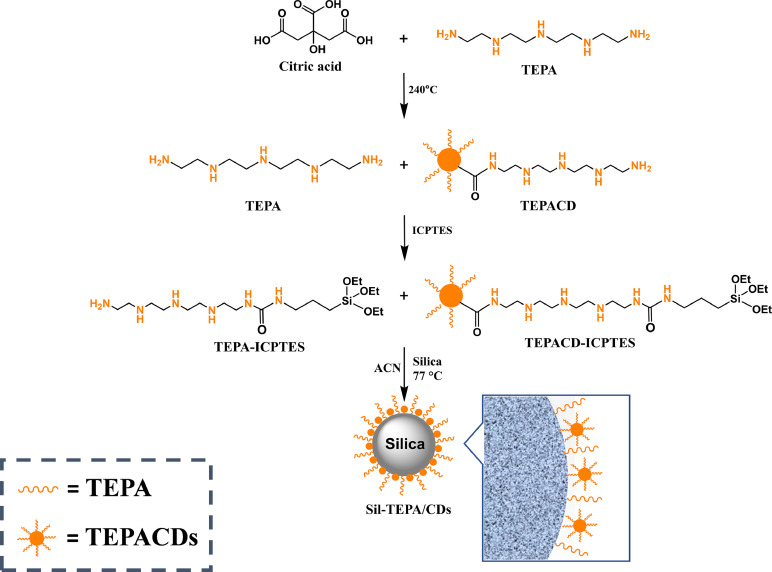Abstract
In this work, tetraethylenepentamine (TEPA) was used as precursor and reaction medium to prepare tetraethylenepentamine-functionalized carbon dots (TEPACDs), the resultant mixture was subsequently silanized and then grafted on the surface of bare silica. The obtained tetraethylenepentamine-functionalized carbon dots and tetraethylenepentamine co-modified silica stationary phase (Sil-TEPA/CDs) was characterized by multiple ways, such as Fourier transformed infrared spectroscopy (FTIR), elemental analysis and transmission electron microscope, which revealed the successful preparation of the mixed stationary phase and higher density of functional groups on co-modified stationary phase than precursor single-modified stationary phase. The synergistic effect of TEPACDs and TEPA was proved by comparing the separation performance of Sil-TEPA/CDs and Sil-TEPA toward amino acids, nucleosides, and nucleobases, which distinctly enhanced the selectivity of SilTEPA/CDs. Thus, 12 nucleosides and nucleobases and 11 amino acids was nicely separated on Sil-TEPA/CDs. By study the influences of the changes of mobile phase composition, mobile phase buffer concentration and buffer pH on the retention behaviors of Sil-TEPA and Sil-TEPA/CDs, it was found that both hydrophilic partitioning and adsorption of analytes on Sil-TEPA/CDs were enhanced benefit from the co-existence of TEPA and TEPACDs, which provided the analytes better separation performance. By comparing the column quality of SilTEPA/CDs with four commercially available columns, Sil-TEPA/CDs exhibited the best peak asymmetry of 0.98, and second best column efficiency of 43895 m-1 using guanosine as analyte. The RSD (n = 9) of the retention times of five selected analytes on Sil-TEPA/CDs were within 0.30-0.61% during 40 h of continuously elution, which implied excellent stability of prepared packing material.

Keywords Plus:RETENTIONNANOMATERIALSADSORPTIONNANOTUBESBEHAVIORACID
Published in JOURNAL OF CHROMATOGRAPHY A,Volume1707,10.1016/j.chroma.2023.464325;SEP 27 2023


